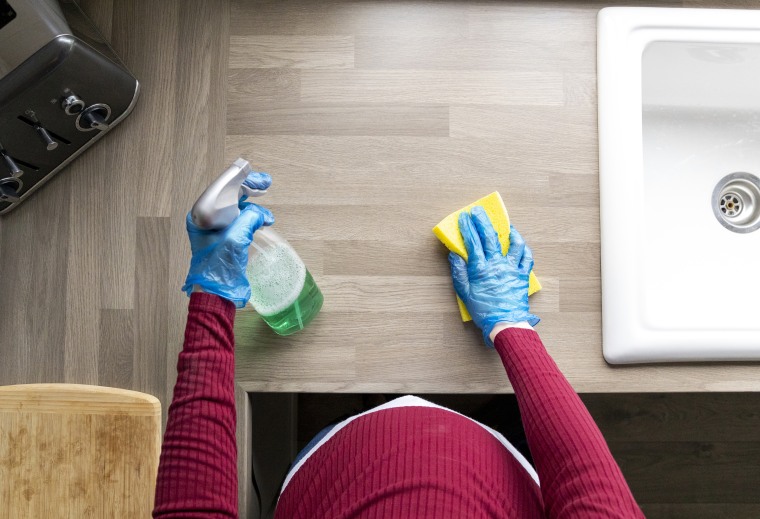Expectant mothers exposed to certain chemicals are more likely to deliver their children prematurely, according to a recent study published in the journal JAMA Pediatrics — the largest on the topic to date.
The study represents a composite of 16 previous studies that analyzed data from 6,045 pregnant women in the United States. The research shows that women with higher concentrations of phthalate metabolites in their urine were more likely to deliver their babies preterm — three or more weeks before the mother’s due date.
“Preterm birth is one of the most poorly understood, intractable challenges in maternal-child health,” Emily Barrett, Ph.D., associate professor of biostatistics and epidemiology at Rutgers School of Public Health and one of the study’s authors, said in a press release. "This study provides compelling evidence that everyday chemicals in our environment are part of the problem."
"The environment around us and the chemicals we encounter in our everyday lives have an impact on a woman’s ability to have a healthy pregnancy,” she added in an interview with TODAY.
What are phthalates?
Phthalates, also called plasticizers, are a class of manmade chemicals used to make plastics more durable and flexible. They're found in many solvents, detergents, personal-care products and food packaging. The Centers for Disease Control and Prevention, Environmental Protection Agency and the Natural Resources Defense Council have all issued multiple warnings about phthalate exposure.
“There is a rapidly growing body of epidemiological studies on the association of exposure to phthalates with human health,” Erik Olson, the senior strategic director of health and food for the Natural Resources Defense Council, told TODAY.
In addition to the preterm labor risks shown in the JAMA Pediatrics study, phthalate exposure has been linked to a host of reproductive, immune and neurological disorders including autism, ADHD, fertility issues and an increased risk of breast cancer, according to Dr. Nathaniel DeNicola, OB-GYN and environmental health expert for the American College of Obstetricians & Gynecologists. “The known risks of phthalate exposure are concerning enough, and there may still be other issues we don’t know about yet,” DeNicola told TODAY.
“Phthalates have also been linked with obesity, a worsening of allergy and asthma symptoms and altered toddler behavior,” Olson said.
What’s more, phthalates are just one of several endocrine-disrupting chemical classes known to be harmful. Others include bisphenol A (BPA), parabens, polybrominated diphenyl ethers (PBDE) and dioxins. Each such chemical class has been associated with numerous disorders in humans.
For instance, Dr. Deborah Campbell, the chief of neonatology at the Children’s Hospital at Montefiore in New York City, told TODAY that BPA exposure can lead to “behavior problems in children and has been linked to asthma, obesity and diabetes.” Earlier this month, TODAY reported on a study that found another class of endocrine-disrupting chemical known as PFAS, also called “forever chemicals,” are contributing to rising rates of liver disease in children.
A person’s endocrine system produces and releases hormones and can be affected by the chemicals you come in contact with through touching, breathing or ingestion. “Phthalates are called ‘endocrine disruptors’ because they affect the body’s hormones by mimicking them or blocking them,” Campbell explained. “They interfere with the body’s natural levels of estrogen, testosterone and other hormones.”
Where phthalates are common
Although it’s difficult to pinpoint which brands use phthalates or other harmful chemicals and to what extent — “You will rarely see ‘phthalate’ on an ingredient list these days,” Barrett said — phthalates are found in a huge number of household goods:
- Cleaners
- Liquids stored in plastic bottles
- Adhesives
- Items made with soft, flexible plastics
- Brightly colored products, such as toys, paints and printer ink
- Cosmetics, such as nail polish, creams and lotions, shampoos and body washes, deodorants, and baby and diaper creams
- Food, especially highly processed ones, which tend to have higher levels than fresh, unprocessed foods
“People living near hazardous waste disposal sites or municipal landfills may be exposed to low levels of phthalates from the air and drinking water,” Olson added.
What parents should know about phthalates
Recognizing how common and ever-present phthalates and other endocrine-disrupting chemicals can be is overwhelming, DeNicola acknowledged, but he said it’s important to balance overreaction with genuine caution.
"It’s virtually impossible to avoid all chemicals," he said. "But there are a few simple things anyone can do to limit exposure." These include:
- Buy products with labels reading "parabens free," "BPA free," or "phthalates free."
- Limit fast food intake. "Most items offered in fast food chains have been wrapped in plastic-coated paper — sometimes for weeks or months on end — which allows harmful chemicals to leak into the food,” DeNicola said.
- Avoid storing or heating food items in plastic containers. “The longer your food is exposed to phthalates present in plastics, the more likely it can seep in,” DeNicola said.
- Microwave foods in glass containers instead of plastic ones, as heating phthalate-lined plastics is known to make contamination more likely, DeNicola said.
- Buy products labeled "fragrance free." "Ask yourself, 'Can I do without air fresheners or scented candles? Can I skip perfume or choose an unscented deodorant?'" Barrett advised.
Understanding when phthalate exposure can do the most harm is important, too. “Though harmful chemicals are bad for anyone, babies in utero or developing children are especially at risk,” DeNicola said, adding that pregnant people need to be especially mindful.
“Phthalate exposure in children can interfere with normal growth and brain development,” Campbell added. “Exposures in the womb and during childhood can lead to health problems later in life.”
The American Academy of Pediatrics also has advice on reducing phthalate exposure.
“Awareness of the widespread use of these chemicals in the products we use every day is an important first step,” Barrett said. “You can’t limit chemical exposures in your home without knowing they’re there in the first place.”

